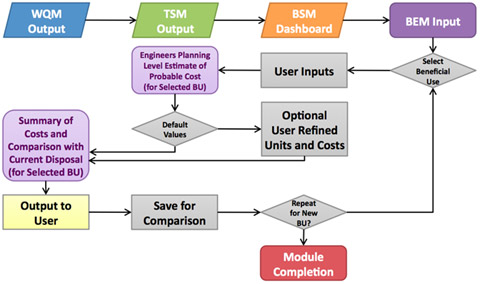Beneficial Use Economic Module
Summary
The purpose of the Beneficial Use Economic Module (BEM) is to help produced water generators, potential beneficial users, and other stakeholders identify estimated, planning-level capital and O&M costs for potential beneficial use projects. The evaluation can be performed for multiple beneficial use categories or variations on a single beneficial use category to allow for comparison of the relative costs between scenarios. Potential social, environmental and other benefits are also estimated quantitatively and/or qualitatively in the BEM to provide a non-economic assessment of beneficially using produced water.
The BEM is the last module in the series of linked modules; it builds off of the output information from the WQM, TSM, and BSM. The BEM also uses scenario-specific user input variables (such as estimated project life, project area, and terrain) to build a cost estimate. The costs are outputted in both a detailed, line-item cost estimate table and a general cost summary. Default variables can be adjusted as necessary to refine the cost estimate or to change the basic scenario.
BEM Flowchart
User Input
The user inputs information about a specific project scenario. The information can be known, such as the location of the project, or can be entered as a variable and changed for comparison during another scenario run. Examples of user input include:
- Beneficial Use (choose one of 12 listed in BSM);
- Nearest City or Town;
- Estimated Project Life (1 through 50 years);
- Long-Term Interest Rate;
- General Type of Terrain (Flat, hilly, or steep); and
- Energy Type (Diesel, natural gas, or grid transmission).
The input data is used to populate the quantity and unit cost data used in the Engineer's Opinion of Probable Costs for the defined project scenario.
Analysis – Engineer’s Opinion of Probable Costs
Capital and O&M costs presented in the BEM were developed based on specific design criteria defined through the TSM, general project criteria based on professional experience, and unit costs for power, chemicals and labor representative of the Denver area (Jan 2010). This cost estimate is developed at a Class 5 level representing Planning to Feasibility level information with an estimated accuracy range between -30% and +50% (AACE 1997, DOE 1994, EPRI 1993).
Output – Cost Template
Information in the Cost Template is populated with user input from the four modules, typical values from project experience, engineering calculations and assumptions. Each line item in the Cost Template is calculated in one of three ways:
- Unit Cost Calculation – where a quantity is multiplied by a unit cost to provide a total capital cost (i.e., 200 linear feet (lf) of pipeline x $120/lf = $24,000)
- Lump Sum Calculation – where the quantity (one) is multiplied by a lump sum cost to provide a total capital cost (i.e., 1 lump sum (LS) treatment train process x $500,000/LS = $500,000)
- Percentage Calculation – where a percent is multiplied by a value or sum of values (i.e., Site development costs = 5% x Subtotal Facility Costs, which estimates the cost for grading, erosion control, cut/fill, etc.)
Annual O&M costs can be added to the annualized capital cost to estimate the total economic cost per year to construct and operate the project over the life of the project.
Output – Cost Summary
The Cost Summary worksheet provides an overview of the economic costs of the project scenario as well as some of the non-economic benefits of beneficially using produced water.
- Estimated Project Capital Cost is based on the location and year of anticipated project construction.
- Total Present Value for Life of Project is calculated using standard economic evaluation:
- User can select the preferred units from the drop down menu ($/bbl, $/gal, or $/AF)
- Estimated Range of Project Annualized Unit Costs is calculated as -30% and +50% of the annualized capital and annual O&M costs calculated in the Cost Template. This provides the User with a idea of the range of costs for a simple to complex project and allows for comparison to the current cost of disposal (as entered by the User)
- Potential Social, Environmental, and Other Benefits are estimated quantitatively and/or qualitatively in the BEM. These values will vary significantly by location and upon site specific conditions and are intended to provide a broad assessment of opportunities that may potentially be available to support the beneficial re-use produced water.
- Potential Emissions Offset and Value is estimated based on a broad assessment or potential emissions savings and possible returns. These values will vary significantly by location, energy source, site-specific conditions, energy market, and the accuracy of the estimated energy for current disposal.
Output – Compare Uses
The Compare Uses worksheet allows the user to compare multiple beneficial uses or variations on a project scenario based on user inputs and the results from the WQM and TSM.
How does this module relate to other modules in the tool?
WQM – The WQM provides inputs for the TSM but does not directly interact with the BSM.
TSM – Results from the TSM are directly input into the Cost Template worksheet to provide capital and O&M costs for the treatment processes associated with the selected beneficial use for the project scenario.
BSM – The BSM helps the user to identify the top 2 or 3 beneficial uses to further asses in the economic evaluation. Information in the Potential Benefits worksheet is also referenced in the BEM.
For more information, please refer to the User Manual.
